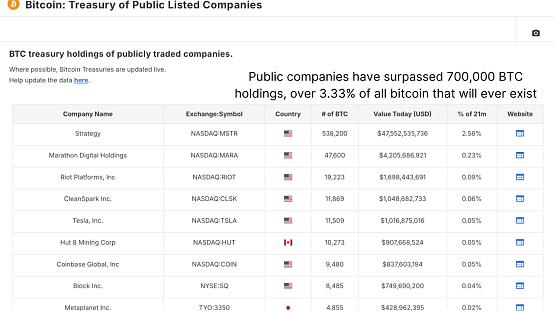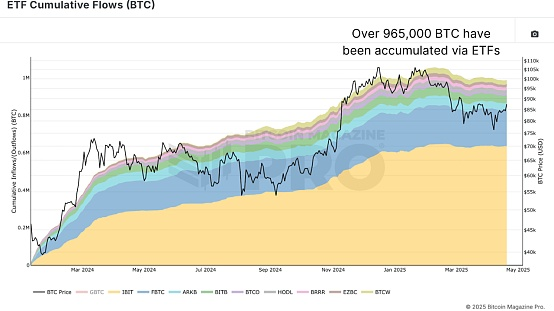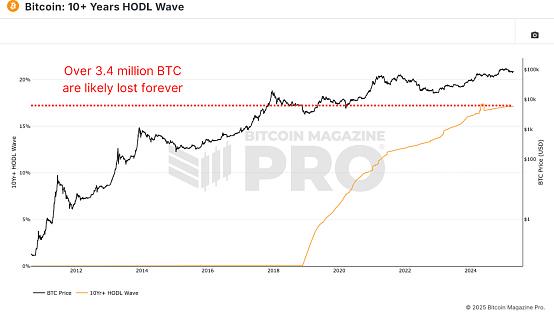8% of Bitcoin is purchased by institutions, who holds huge amounts of Bitcoin
 2025-05-26 11:00
2025-05-26 11:00When it comes to the values of the crypto world, the concept of decentralization is the most well-known one.
Tracing back to its origins, the emergence of cryptocurrency coincided with the bankruptcy of Lehman Brothers. Against the backdrop of global currency crisis turmoil, Satoshi Nakamoto proposed the concept of decentralized currency, and Bitcoin emerged, laying the foundation for the value belief of the crypto world. In the not-so-long decade that followed, around decentralization, the crypto ecosystem continued to expand and grow, and value beliefs and technical beliefs went from controversy to unity, and then from unity to decentralization, surging and developing in the theory of value and price. However controversial it may be, Bitcoin is the strongest value pillar in the crypto world. From miners to mining farms, from capital to institutions, despite the constant changes in the so-called "manipulators" around Bitcoin, the market firmly believes that no one can own more than 51% of Bitcoin and recognizes it as a successful demonstration sample of decentralized currency.
But in recent years, decentralized currencies seem to have returned to the context of centralization. Since 2020, Wall Street institutions and Listed Companies have started the Bitcoin buying frenzy. Last year, the Bitcoin spot ETF was listed, and now, with the establishment of the US Bitcoin strategic reserve, it can be seen that institutional investors, Listed Companies, and even countries have begun to hold a large amount of Bitcoin. This move has its advantages and disadvantages. The advantage is the high price, and the injection of liquidity has successfully pushed Bitcoin to $100,000, not only leaving a significant mark in the history of encryption, but also truly giving glory to diamond hands. Compliance makes the threshold for holders higher. Cryptocurrency has entered the mainstream for the first time, and speculators hiding in the dark have transformed into Value Investors, while also being labeled as emerging asset holders.
However, the disadvantages are also obvious. Miners are moving behind the scenes, and the linkage between the cryptocurrency market and the US stock market is becoming increasingly close. Independent market trends are difficult to find, and macroeconomic changes are stimulating the fragile nerves of the market. The current market has well demonstrated this point. People's attention is either on the tariff war, discussing US interest rate cuts, or researching the inflow and outflow of ETFs. The priority of technological progress is constantly recursing. Compliance and regulation have not made the cryptocurrency market sunny, but instead let the president take the opportunity to cut the first batch of leeks. The family MEME turmoil continues, and Defi and blockchain games need to be caught.
Combining all of the above, questions are also emerging: who holds the most Bitcoin? Is the continuous growth of institutional investors a good thing for Bitcoin? As more and more BTC is locked in cold wallets, government bonds, and ETFs, is the on-chain data losing reliability? In response to this issue, Bitcoin Magazine reporter Matt Crosby has also conducted research, translating his report here to explain whether the decentralized spirit of Bitcoin is truly at risk or just evolving.
New whale
Let's start with the financial data of Listed Company. In terms of data, large Listed Companies including Strategy and MetaPlanet have accumulated more than 700,000 BTC. Strategy is undoubtedly the leader among them. As of April 21, 2025, Strategy holds 538,200 BTC, with a total purchase cost of about $36.47 billion and an average price of about $67,766. In the past six months, it has acquired 379,800 BTC. Considering that the total supply limit of Bitcoin is 21 million, this accounts for about 3.33% of the total future BTC supply. Although this supply limit cannot be reached in the lifetime of current holders, the phenomenon reflected is obvious: listed companies are making long-term bets.

Figure 1: Listed Companies with the Highest BTC Holdings
In addition to the Bitcoin directly held by enterprises, it can be seen from the EFT cumulative flow (BTC) chart that ETFs also occupy a considerable share. As of the writing of this article, the spot Bitcoin ETF holds about 965,000 BTC, slightly less than 5% of the total supply. This number has relatively limited fluctuations, but it is still the main force affecting daily market dynamics. Taking BlackRock as an example, according to BlackRock data, the IBIT fund was launched in January 2024 along with 10 other US spot Bitcoin ETFs, and currently has a net asset of about $53.77 billion. In the past 30 days, the average daily trading volume of the fund has reached 45.02 million shares. If the holdings of corporate bonds and ETFs are combined, the number will climb to more than 1.67 million BTC, accounting for about 8% of the theoretical total supply, but this data is still more than that.

Figure 2: ETFs have sparked institutional interest in BTC
Apart from Wall Street and Silicon Valley, some regional and national governments are now widely active in the Bitcoin field. Through sovereign purchases and strategic Bitcoin reserves, the region and the country hold about 542,000 bitcoins. Adding previous institutional holdings, it can be concluded that the number of bitcoins held by institutions, ETFs, and governments exceeds 2.20 million. On the surface, this accounts for about 10.14% of the total Bitcoin supply of 21 million.
The Forgotten Satoshi Nakamoto and the Lost Supply
In fact, not all 21 million BTC can be accessed and tracked. According to the "10 + years HODL Wave" data (which measures coins that have not been moved in ten years), more than 3.4 million BTC may have been lost forever, including Satoshi Nakamoto's wallet, coins from the early mining era, forgotten passwords, and even USB drives in landfills.

Figure 3: It is conceivable that the amount of BTC lost exceeds 3.40 million
Currently, there are about 19.80 million BTC in circulation, and it is estimated that about 17.15% have been lost, so the actual supply is close to 16.45 million. This completely changes the current balance, and the proportion of BTC held by institutions has risen to about 13.44% in terms of more actual supply. This means that about 1 out of every 7.4 BTC in the market has been locked by institutions, ETFs, or sovereign countries.
In this context, are institutions capable of controlling Bitcoin?
Fortunately, from the data, there is currently no such trend. However, this does indicate that its influence is increasing, especially in terms of price behavior. Looking at the correlation chart between the S & P 500 Index and Bitcoin, the correlation between Bitcoin and traditional stock indices such as the S & P 500 Index or NASDAQ has significantly increased. As these large entities enter the market, BTC is increasingly seen as a "risk appetite" asset, which means that its price often fluctuates with changes in traditional market investor sentiment.

Figure 4: The correlation between Bitcoin and the Standard & Poor 500 Index continues to grow
This will be relatively advantageous in a bull market. When global liquidity expands and risky assets perform well, Bitcoin is now expected to attract larger inflows than ever before, especially as pension funds, hedge funds, and sovereign wealth funds begin to allocate their investment portfolios (even if only a small part). However, there is also a trade-off. As institutional adoption deepens, Bitcoin's sensitivity to macroeconomic conditions will increase. Central bank policies, bond yields, and stock volatility are all becoming more important than ever.
Despite these changes, over 85% of Bitcoin has not yet entered the hands of institutional investors. Retail investors still hold the vast majority of Bitcoin supply. ETFs and corporate vaults may have hoarded large amounts of Bitcoin in cold wallets, but the market is still highly decentralized. Some industry critics believe that the usefulness of on-chain data is weakening. After all, if so much BTC is locked in ETFs or idle wallets, can we still draw accurate conclusions from wallet activity? Although this concern is not groundless, it is not new either.
New adaptation
Historically, most of Bitcoin's trading activities have occurred off-chain, especially on centralized exchanges such as Coinbase, Binance, and the former FTX. These transactions rarely appear on-chain in a meaningful way, but still affect prices and market structure. Today, the market faces a similar situation, but with better tools. ETF fund flows, company filings, and even state purchases are subject to information disclosure regulations. Unlike opaque exchanges, these institutional participants usually have to disclose their holdings, which provides analysts with a lot of tracking data.
In addition, on-chain analysis is not static. Tools like MVRV-Z score are constantly evolving. By narrowing the focus to the 2-year rolling average of MVRV Z score rather than complete historical data, current market dynamics can be better captured without being affected by long-term lost tokens or inactive supply.

Figure 5: More targeted 2-year rolling MVRV Z scores can better capture market dynamics
Conclusion
In short, institutional investors' interest in Bitcoin is unprecedentedly high. Among ETFs, corporate bonds, and sovereign entities, the number of Bitcoin holdings has exceeded 2.20 million, and this number is still growing. During the market downturn, the influx of funds undoubtedly stabilized the price. However, this stability also brought some entanglements. Bitcoin is increasingly closely linked to the traditional financial system, and its correlation with stocks and broader economic sentiment is also increasing.
This does not mean the end of the era of Bitcoin decentralization or on-chain analysis. In fact, as more and more Bitcoins are held by identifiable institutions, the ability to track fund flows will become more accurate. Retail investors still dominate, and on-chain and off-chain analysis tools are becoming smarter and more responsive to market changes. The spirit of Bitcoin decentralization is not threatened, it is just maturing. As long as the analysis framework and Bitcoin can keep up with the times and develop together, they can inevitably meet the corresponding challenges in the future.
Latest news
-

- See more
Bitcoin breaks through 110,000 dollars, regrets and misses of those years
On May 22, the 14th anniversary of Bitcoin Pizza Day, Bitcoin broke through the ...
 2025-05-26
2025-05-26
-

- See more
Rethinking Bitcoin's Lightning Network Design from a Thunderbolt Perspective
Why can't I buy coffee with bitcoin?When most people think of Bitcoin, the first...
 2025-05-26
2025-05-26

